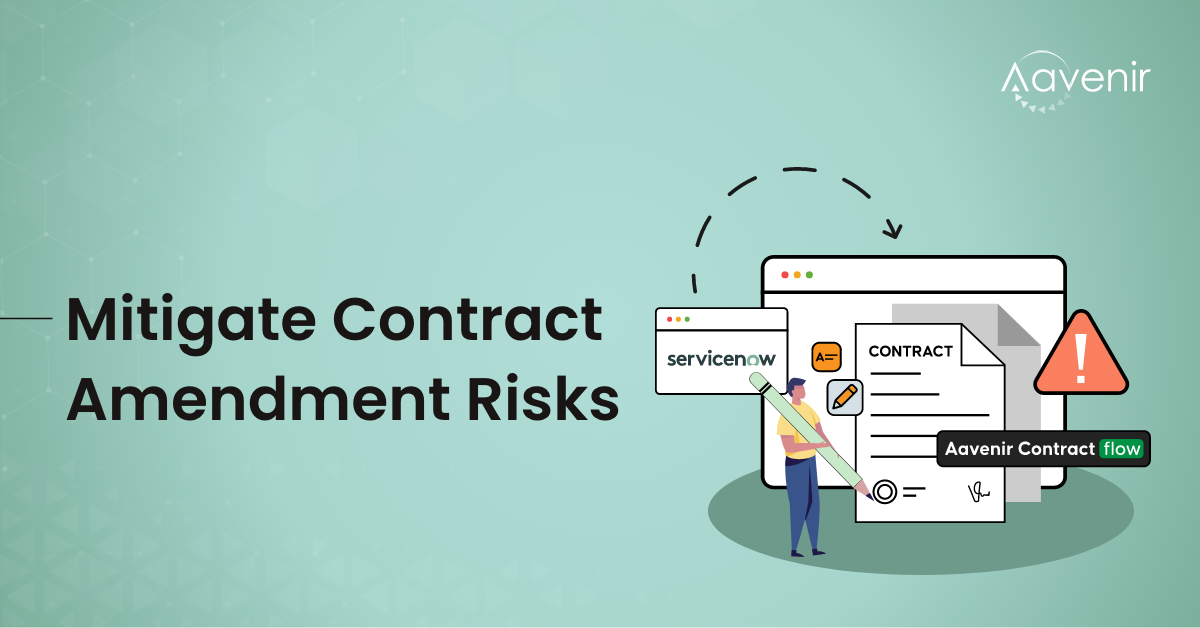The only thing constant in life is change; it is equally applicable to contract management.
The average company has 20,000-40,000 contracts.
Often these contract documents go through amendments either on mutual consent or due to legislative requirements. How do you make sure contract amendment risks are adequately addressed and mitigated?
Contracts are very complex and their management is even more complex. Contracts are the backbone of any organization and define the relationships with customers, vendors, employees, and partners. When a contract is signed and the cycle of contract management picks up pace, at each stage, there is some risk involved.
- The financial risk such as revenue leakage,
- The legal risk of non-compliance and missed obligations,
- The security risk of a data breach,
- The brand risk of negative customer touchpoints, and the list goes on.
If we specifically talk about contract amendments risks, amongst all, it is highly prone to pose a legal risk. First, let us understand the when and why of contract amendments.
When and Why of Contract Amendment Risks
Contract amendments, i.e. additions, deletions, and corrections to the original agreement, are important. When the business situation or government legislative situation changes, the relationship of contracting parties could be impacted quite significantly from what was agreed upon at the outset, and an amendment is essential, the risk profile associated with that contract also changes.
The given scenario may be considered as an example of why need an amendment in the contract and how contract amendment risks may be addressed and mitigated:
Amending an Existing Contract
You may need to make amendments to your existing live agreements. For example, as per your vendor contract, you can expect a shipment within 14 days of PO. However, based on your past experiences, you know that it generally takes around 20 days (nearly 3 weeks). And, this variation is consistently observed over a span of 6 months. Timeline terms are often an important element of agreements. In this case, one possibility is that you could re-negotiate a revised term with your vendor that the shipment would be supplied within 3 weeks of PO, and by any chance, if there is a delay than the agreed period, that would attract a penalty of, say 5%.
In this case, an amendment in the delivery clause, as well as the payment clause, would be required.
A properly drafted and executed amendment is attached to the original contract and treated as part of the original contract. In case the amendment is not attached, and if a dispute arises, there are possibilities that the actual terms of the original contract are not enforceable.
Mitigate Contract Amendment Risks
Contract risk management is a much-talked-about topic. Contract risk mitigation requires careful attention to details and enforcement of agreed terms.
In any organization, the decision-making team is usually responsible for contract negotiations and contract revisions.
During the contract’s lifecycle:
- The contract experts deal with the vendors, clients, or partners to negotiate the terms
- The management team is in charge of keeping track of negotiations, related amendments, and revisions.
The legal team, then, verifies the legality of the contract amendments. Lastly, the updates are carried out by the management team by attaching the addendums to the existing deal.
Precautions to be taken and best practices to be followed while amending contracts to mitigate contract amendment risks:
- Contract changes should always be carried out in written form and signed/dated by both parties.
- While making changes to a contract, it is critical to provide the justification for the adjustments, to all contracting parties. Every revision made to the original contract terms must be accompanied by substantial evidence.
- Send out all notifications diligently to all parties involved, otherwise, it may lead to further challenges and create confusion among the team
- The title of the contract should be clearly referenced including original parties and original signing date. So, it becomes clear to all parties that which clause/section is amended and what were the original terms.
- Always rewrite the entire section (or paragraph) of the contract with the revisions to make it obvious what the regulating language was.
- It is not advisable to make multiple amendments, especially, if you're amending previous amendments. In such situations, drafting a new contract with clearly laid out terms and conditions makes more sense.
- Once the document has been signed, as an acknowledgment, attach it with the original document so that it can be formally put into effect. An amendment is a neat and tidy legal way to make changes to an existing contract so there is no room for misunderstanding.
But are there any better ways to ensure a streamlined contract amendment process? What if some contracts need extensive changes? What if your business needs frequent changes in contracts? To what extent is legal intervention necessary for contract amendments?
The one-stop solution to all these challenges is an intelligent contract management system that takes out the pains and makes the entire process transparent, smart, and effective, and offers an automated workflow to make your contracting process streamlined, fast and accurate. Contract lifecycle management software is the simplest way to make changes to your contracts.
Contract Management on ServiceNow
Say no to missed opportunities due to contract amendment risks and say yes to effective contract management that prevents revenue leakage and mitigates risks before they occur.
Despite all the difficulties and challenges to maintain and accommodate the amendments, with effective CLM software and an experienced contract management team, the amendments can be handled efficiently.
Aavenir Contractflow, an AI-enabled contract management software, built on the NOW platform, automates workflows and leaves no room for missed opportunities or unnoticed areas of attention. It helps contracting parties track all the changes and revisions to a contract during its entire lifecycle, across all stages. Not only will it aid you to make the changes, but will also help you keep track of all versions.
With Contractflow, when the need for amendment arises, you don’t need to start from scratch. Simply attach updated sections to your existing contract, a version control number will be assigned to the transaction automatically. In other words, it manages to create the latest version of the record and saves the previous version for reference minimizing the risk of misplacement of amended clauses.
Over and above, it helps:
- mitigate legal risk with increased compliance
- mitigate security risk with contract version control within a secure, centralized repository
- mitigate financial risk by shortening time-to-signature with secured approvals and eSignatures
So, are you ready to enforce business processes and mitigate contract amendment risks using automated workflows on ServiceNow? Get started now, start your FREE trial from ServiceNow App Store.


